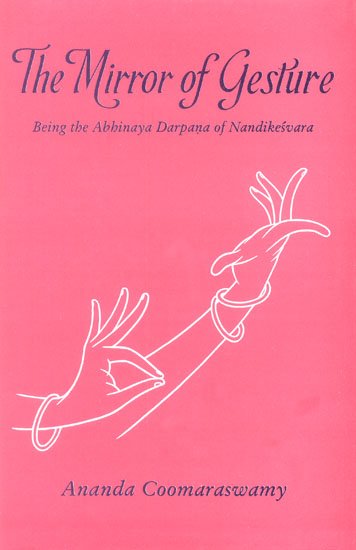Abhinaya-darpana (English)
by Ananda Coomaraswamy | 1917 | 16,981 words | ISBN-13: 9788121500210
The English translation of the Abhinaya-darpana (“the mirror of gesture”) by Nandikeshvara: an encyclopedic manual of the art of gesticulation. It belongs to a wide range of literature known as Natya-shastra: the ancient Indian art of dramatic performance, theatrics, dance and music. The Abhinaya Darpana is an abridgement of the Bharatarnava, a m...
Chapter 14 - Twenty-six Combined Hands
Combined Hands (samyutta hastāni):
According to another book the (twenty-six) combined hands are as follows:
Avahittha: Śukatuṇçla hands held against the heart. The patron deity is Mārkaṇḍeya. Usage: debility, wasting of the body, eager interest, thinness.
Gajadanta (elephant’s tusk):[1] Sarpa-śīrṣa hands, the middles of the arms boldly crossed. Patron deity Paramātmā. Usage: grasping a pillar, pulling up a stone, lifting anything heavy.
Caturaśra (square): Kaṭaka-mukha hands are held before the chest. Patron deity Varāhi. Usage: churning, Jakkiṇīnaṭana, holding, milking, covering with cloths, wearing pearls, dragging ropes, tying the girdle, tying the bodice, holding flowers, etc., plying the fly-whisk.
Tala-mukha (palms facing): two hands raised face to face before the chest, (not touching). Patron deity Vijñarāja. Usage: embrace, stout things, a thick pillar, a sweet-sounding drum.
Svastika (crossed): Tripatāka hands crossed on the left side. Patron deity Guha. Usage: Wishing-tree, mountains.
Āviddha-vakra (swinging curve): vyāvṛtta Patāka hands are shown with grace and with (movement of) the elbows. Patron deity Tumburu. Usage: tying the girdle, difference, slenderness of waist, folk dances (deṣya naṭana).
Recita: Haṃsa-pakṣa hands face upwards, held apart. Patron deity Yakṣarāja. Usage: holding children, showing a painted panel (citra-phalaka).
Nitamba (buttock): Patāka hands face upwards, turned over, (extended from) the shoulder to the buttocks. Patron deity Agastya. Usage: weariness, descent or entry (avataraṇa), astonishment, ecstasy, etc.
Latā (creeper): Patāka hands held like a swing. Patron deity Sakti. Usage: being heavy with drink, beginning (the dance called) svabhāva naṭana, lines, state of union (yoga-condition), etc.
Pakṣa-vañcita (bent wing): Tripatāka hands are placed upon the hips. Patron deity Arjuna. Usage: movement of the thighs, difference.
Pakṣa-pradyota (shining wing): Pakṣa-vañcita hands face upwards. Patron deity Siddha. Usage: despondence, loss of wits, strangeness, magic boar, pot gesture (kumbhābhinaya).
Garuḍa-pakṣa (Garuḍa wing): Ardha-candra hands held at the sides of the hips, extended upwards. Patron deity Sanandana. Usage: waist string, superiority.
Niṣedha (defence): the Mukula hand enclosed by the Kapittha hand. Patron deity Tumburu. Usage: establishing the conclusion of an argument, truth, saying “Verily”, holding the nipples, anga-pūja.
Makara: Ardha-candra hands, one enclosing the other, palms downwards, the thumbs moving. Patron deity Mahendra. Usage: the sea, overflowing of a river, deer-face, prosperity, solidity, platform, crocodile.
Vardhamāna (increase): Haṃsa-pakṣa hands palms down, turned together face upwards. Patron deity Vāsuki. Usage: Narasiṃha, his glory, tearing the rākṣasa’s chest.
Udvṛtta (asunder): one Haṃsa-pakṣa hand held face downwards and one face upwards. Patron deity Vāsiṣṭha. Usage: modesty, simile, torment, thorns etc., difference, consideration.
Viprakīrna (loosed): Svastika hands quickly separated. Patron deity Dakṣina-mūrti. Usage: drawing away the end of the robe (celāñcala), releasing.
Arāla-kaṭaka-mukha: Arāla and Kaṭaka-mukha hands held crossed. Patron deity Vāmana. Usage: giving pieces of betel leaf, anxiety, dismay.
Sūcyāsya (needle-face): Sūci hands are moved aside from the front simultaneously. Patron deity Nārada. Usage: saying “What am I to do?”, yearning for the beloved, saying “Everything”, or “Look here.”
Ardha-recita: of two Recita hands one is held palm downwards. Patron deity Nandikeśvara. Usage: invitation, giving presents, concealing actions.
Keśa-bandha (tying the hair): Patāka hands binding the hair. Patron deity Durgā. Usage: gem-pillar, binding the hair, cheek, etc.
Muṣṭi-svastika (crossed fists): Muṣṭi hands are crossed on the stomach. Patron deity Kiṃpuruṣa. Usage: playing ball, boxing, great bashfulness, tying the girdle.
Nalinī-padmakośa: Padmakośa hands are outward-turned and crossed. Patron deity Śeṣa. Usage: nāga-bandha, buds, making equal distribution, cluster of flowers, the number ten, Gaṇḍa-bheruṇḍa. (Identical with Nalina-padmakośa; Introduction, pp. 4, 5.)
Udveṣṭitālapadma: Alapadma hands are held on the chest and twisted upwards. Patron deity Sakti. Usage: husband, humble words, the breasts, full-blown lotus, saying “I am beloved”, conversation, indicating desires. (Plates XI e XIIID.)
Ulbaṇa (abundance): the same hands held close to the eyes. Patron deity Vijñeśa. Usage: large clusters of flowers, eyes.
Lālita: the same hands crossed near the head. Patron deity Vaiṣṇavī. Usage: sāl-tree, mountain.
Footnotes and references:
[1]:
Quite distinct from the Gaja or Daṇḍa hand of T. A. Gopinatha Rao, “Hindu Iconography”, Vol. I, pt. i, p. 16, and ibid., PI. V, fig. 12, illustrated here on Plates I and III.
